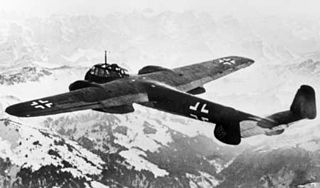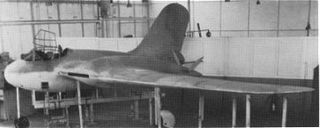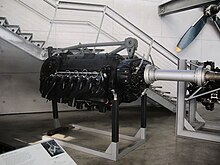
The Dornier Do 215 was a light bomber, aerial reconnaissance aircraft and later a night fighter, produced by Dornier originally for export, but in the event most served in the Luftwaffe. Like its predecessor, the Dornier Do 17, it inherited the title "The Flying Pencil" because of its slim fuselage. The successor of the Do 215 was the Do 217.

The Dornier Do 335Pfeil ("Arrow") was a heavy fighter built by Dornier for Germany during World War II. The two-seater trainer version was called Ameisenbär ("anteater"). The Pfeil's performance was predicted to be better than other twin-engine designs due to its unique push-pull configuration and the lower aerodynamic drag of the in-line alignment of the two engines. It was Nazi Germany's fastest piston-engined aircraft of World War II. The Luftwaffe was desperate to get the design into operational use, but delays in engine deliveries meant that only a handful were delivered before the war ended.

The Dornier Do 217 was a bomber used by the German Luftwaffe during World War II as a more powerful development of the Dornier Do 17, known as the Fliegender Bleistift. Designed in 1937 and 1938 as a heavy bomber but not meant to be capable of the longer-range missions envisioned for the larger Heinkel He 177, the Do 217's design was refined during 1939 and production began in late 1940. It entered service in early 1941 and by the beginning of 1942 was available in significant numbers.

The Dornier Do 24 is a 1930s German three-engine flying boat designed by the Dornier Flugzeugwerke for maritime patrol and search and rescue. A total of 279 were built among several factories from 1937 to 1945.

The Junkers Ju 288, originally known within the Junkers firm as the EF 074, was a German bomber project designed during World War II, which only ever flew in prototype form. The first aircraft flew on 29 November 1940; 22 development aircraft were eventually produced.

The Focke-Wulf Fw 191 was a prototype German bomber of World War II, as the Focke-Wulf firm's entry for the Bomber B advanced medium bomber design competition. Two versions were intended to be produced, a twin-engine version using the Junkers Jumo 222 engine and a four-engine variant which was to have used the smaller Daimler-Benz DB 605 engine. The project was eventually abandoned due to technical difficulties with the engines.

The Heinkel He 118 was a prototype German monoplane dive bomber design that lost out to the Junkers Ju 87 Stuka in the 1930s, and was never ordered by the Luftwaffe.

The Daimler-Benz DB 603 was a German aircraft engine used during World War II. It was a liquid-cooled 12-cylinder inverted V12 enlargement of the DB 601, which was in itself a development of the DB 600. Production of the DB 603 commenced in May 1942, and with a 44.5 liter displacement figure, was the largest displacement inverted V12 aviation engine to be produced and used in front line aircraft of the Third Reich during World War II.

The Henschel Hs 130 was a German high-altitude reconnaissance and bomber aircraft developed in World War II. It suffered from various mechanical faults and was never used operationally, only existing as prototype airframes.
The Dornier Do 317 was a prototype German medium bomber of World War II.

The Messerschmitt Me 329 was a design project for a heavy fighter and ground-attack aircraft, developed towards the end of World War II. It was a competitor and possible successor to the Me 410. Like the Me 265, the Me 329 used an advanced flying wing design. Other advanced features included the pilot and navigator sitting side by side in a broad bubble canopy, and a remote-controlled rear gun in the tail. In spite of the futuristic design, the improvement in performance over the Me 410 was marginal. Development received a low priority, and while a full-scale glider was tested at Rechlin in the winter of 1944/5, work on the project was cancelled shortly after.

The Heinkel He 119 was an experimental single-propeller monoplane with two coupled engines, developed in Germany. A private venture by Heinkel to test radical ideas by the Günter brothers, the He 119 was originally intended to act as an unarmed reconnaissance bomber capable of eluding all fighters due to its high performance.

The Dornier Do E was a small German flying boat of 1924, designed for reconnaissance missions.

The Arado Ar 77 was a German twin-engined monoplane, designed as an advanced training aircraft from 1934.

The Zeppelin-Lindau Rs.IV was a Riesenflugzeug monoplane all metal flying boat with a stressed skin hull and fuselage developed for the Imperial German Navy to perform long range patrols over the North Sea. It had been developed by Claudius Dornier while working for Zeppelin in the town of Lindau.

The Dornier Do S was a 22-passenger flying boat airliner flown in Germany in 1930.
The Blohm & Voss P 163 was a design project for an unconventional bomber during World War II. Constructed mainly from steel, its crew were accommodated in large wingtip nacelles, giving it a triple-fuselage appearance. Its propeller drive system was also unusual, with the central fuselage containing twin engines coupled to a front-mounted contra-prop.

The LFG V 3 Susanna was a three seat, high wing monoplane flying boat with a single, pusher configuration engine mounted above the wing. A later variant, the LFG V 3a Susanne, was a bigger, more powerful four-seater. Only one of each was built.
The Göppingen Gö 8 was a 1/5 scale model of the Dornier Do 214, a large projected trans-atlantic long-range flying boat, designed by Dornier Werke GmbH in Germany during World War II. The Gö 8 was used primarily to validate the hydro-dynamic and aerodynamic properties of the Do 214.
The Dornier Do 417 was a twin-engine multirole bomber. Developed in 1942, it emerged from the Luftwaffe's request for a medium bomber, a contest for which Dornier, Junkers, Heinkel, and Blohm & Voss competed. In the end, the Junkers Ju 188 was chosen as the aircraft, and the Do 417 never entered production.

















